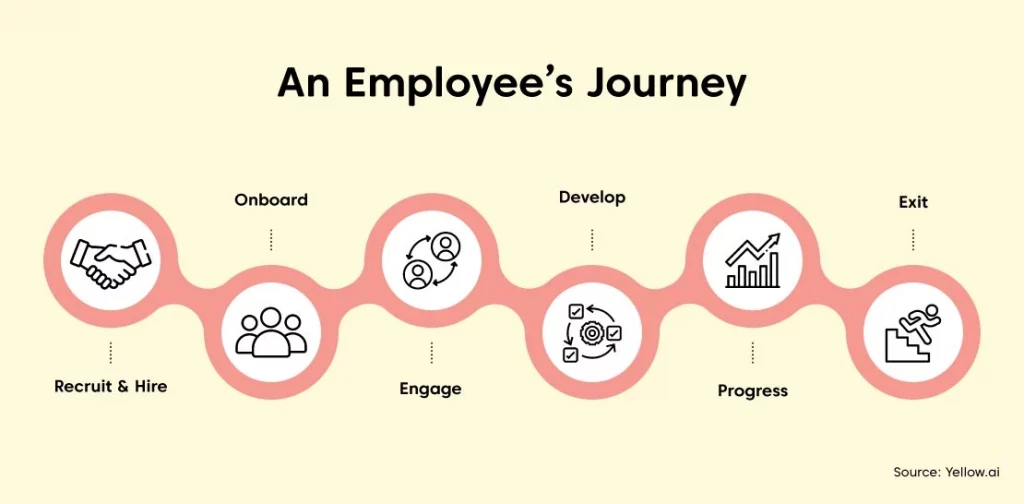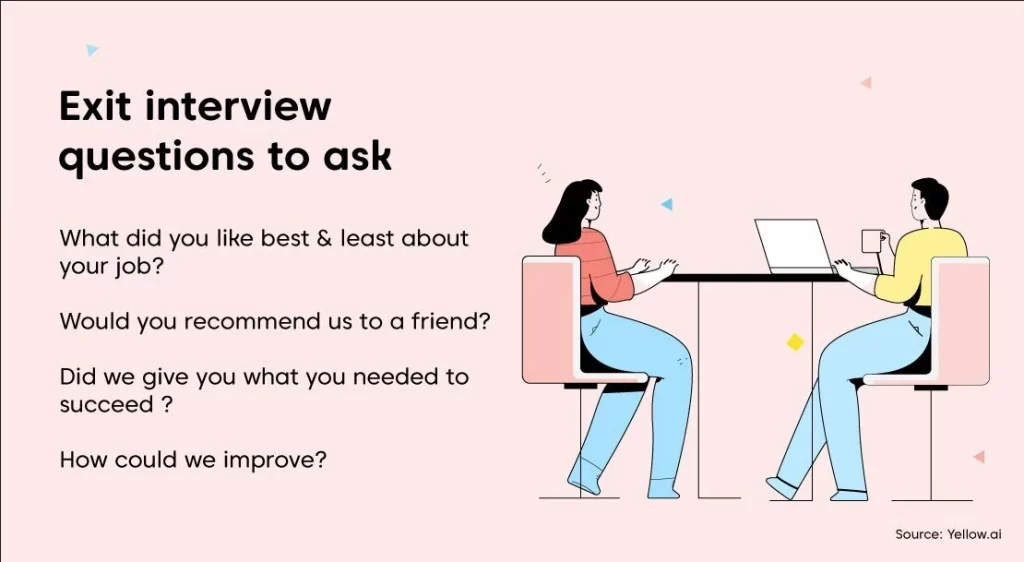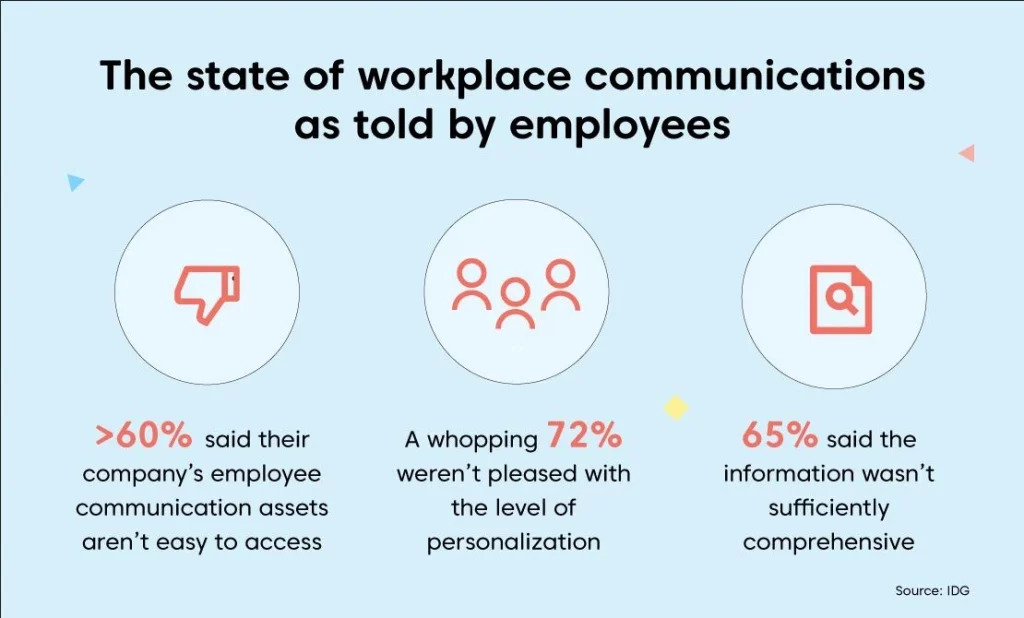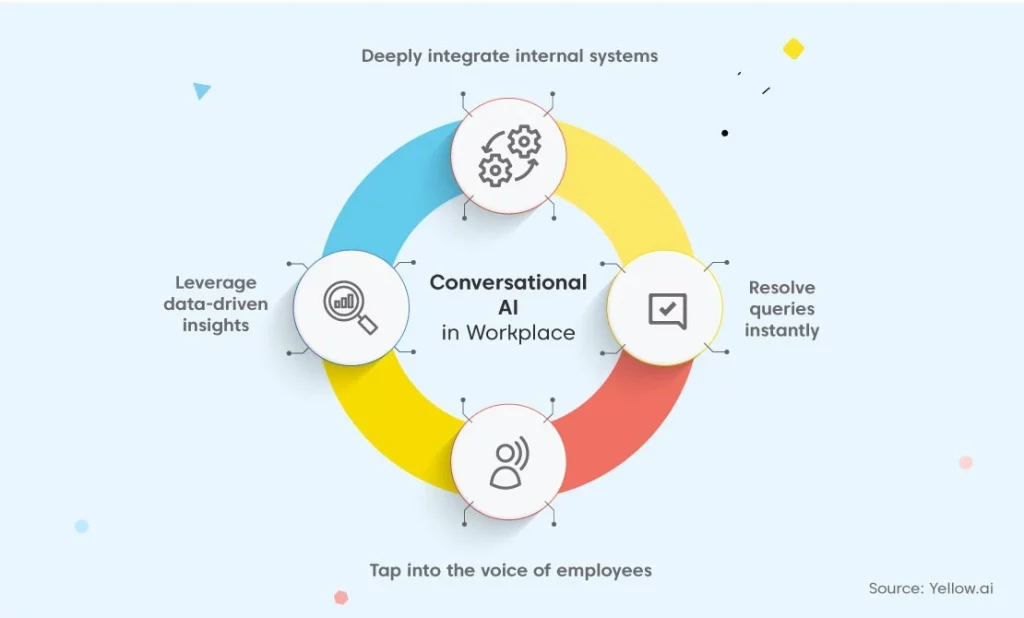Employee journeys are transforming, especially since the emergence of hybrid workplace models. Following the same EX strategy may not be enough to keep your employees engaged and satisfied. This is why you need to revamp your employee experience strategies and adapt them to the new normal. In this blog, we’ll learn about everything you need to craft a winning EX strategy for the year ahead.
Get Your Free Template
What is an employee experience strategy?
Employee experience is the accumulation of all the interactions that happen throughout an employee’s journey with your company. It is what your employees feel about working at your organization. An employee experience strategy, on the other hand, means evaluating every stage of employees’ lifecycle to design an experience that boosts individual and team satisfaction.
Analyzing the employee journey is an important component of creating an employee experience strategy. Following are the 6 steps of an employee lifecycle.

1. Attract
The employee experience roadmap starts even before an employee is hired. It starts right from the time a candidate comes across your job posting. This is why many companies do thoughtful and intentional branding of their company on job listing sites and social media to effectively attract talent.
2. Hire
Hiring can be a long and tedious process. It has three key segments- planning, recruiting and employee selection which can take an average of 23 days to complete according to employment site, Glassdoor. A hiring process that is complicated and slow, can be a turn-off for great candidates.
3. Onboard
Employee onboarding can be a complex process because it touches so many enterprise systems such as HCM, ERP, payroll, service management, training, etc. Poor onboarding is a major cause of employee turnover, which can cost a company 100-300% of the employee’s salary in total.
4. Retain
Once on the job, it all comes down to how effectively you can engage your employees, help them understand their responsibilities and align them with organizational goals. Meanwhile, it’s also important to care about their well-being and offer work-life-balance. In order to make sure employees are happy with their jobs, businesses must also conduct regular employee surveys and managers should solicit feedback from their team frequently.
5. Develop
Investing in employee learning and development is important to help employees acquire new skills, sharpen existing ones and perform better. Since a company is the sum total of what employees achieve individually, organizations should do everything in their power to ensure that employees perform at their peak.
6. Exit
When employees leave, it’s a valuable opportunity to gather deeper insights into your workplace culture, day-to-day processes, management solutions and employee morale. Employees are likely to be more candid in their exit interviews and HR must take advantage of this feedback to shape future initiatives.

5 Steps to creating an employee experience strategy
As we discovered, an EX strategy is about optimizing employee experience at every step of their journey. You need a well-laid step-by-step roadmap to help you achieve that.
1. Analyze your current strategy
Before you set goals, it’s important to understand where you currently stand. This would require the collaboration of HR with all the managers, senior leadership, as well as employees. You must look at various quantitative metrics such as turnover, absenteeism and goal-completions. This will help you determine whether your current EX strategy aligns with your organization’s mission or not.
2. Define scope and objectives
Based on the insights you gain from the step above, you can determine the goals of your strategy. There is no one set strategy for the dynamic work culture today. You might have to design multiple roadmaps and consolidate them into a unified view, so as to improve the overarching employee experience.
For instance, your current strategy may work for the employees that come to office but it might not for remote workers. You might have to look into the journeys of different employee personas to define the scope.
3. Leverage the right tools
An employee experience strategy is not something that you set and forget. It requires continuous improvement and iteration for which you need certain tools like HRMS (human resource management software) and HR automation. These technologies can help offer a central place to view feedback and track key metrics, as well as, automate feedback collection.
Get in touch with our experts to know how you can collect employee feedback at scale with the help of HR automation.
4. Decide the metrics to measure success
Determining the goals and creating a roadmap might not be enough. You also need to make sure you’re progressing in the right direction, which is why deciding KPIs is important. Some essential metrics to measure employee experience are employee satisfaction (can be measured with the help of surveys), employee turnover rate, net promoter score (can be measured by tracking employee reviews on job listing sites), etc.
5. Assess and iterate
Based on the metrics above, you must continually evaluate your strategy and use the insights to improve it with time. Your employee experience strategy must be flexible and easy to adapt to any new iterations. Keep in mind that with changing employee journeys, the experience must also evolve, so that your company can attract and retain more talent. An enhanced employee experience can help your business earn a reputation as a great place to work.
How to improve the hybrid employee experience?
According to Gartner, up to 74% of U.S. companies are already using or planning to implement a permanent hybrid work model. This means employees will have more flexibility to either work from home or join the on-site team. Traditional EX strategies were focused on improving employee experiences at a singular work location. However, now, HR would have to look for ways to improve in a model where people can work from anywhere, anytime.
Here are a few ways in which you can improve the employee experience in a hybrid work model.
1. Keep communication channels open
Invest in employee engagement apps that can improve peer-to-peer collaboration and communication. These apps can also help you send message blasts and alerts for important updates, to all employees no matter where they are situated and the best thing is, unlike email, your messages won’t get lost.

2. Gather continuous feedback
Analyzing and collecting employee feedback from time to time (once a year is not enough!) will help you identify gaps in your employee experience strategy and optimize your efforts. However, collecting feedback in the hybrid work model can be challenging.
With the help of chatbots, you can take employee surveys to the next level. You can use chatbots to gather anonymous employee feedback that can help you get essential, actionable insights into company culture, employee engagement and employee satisfaction. It is easier for employees to share feedback with a bot than with a manager.
3. Build the infrastructure that’ll support flexible work
Making a shift from a conventional work environment to a more hybrid structure is followed by certain challenges like team silos, communication breakdowns and information loss. Most importantly, work-from-home employees can find it difficult to resolve their day-to-day queries.
Conversational AI-based workplace solutions provide timely resolution of queries – requested by employees through their preferred channels at their convenient time. Leading to employees wasting less time on multiple systems/access points to get their queries resolved and can focus on business deliverables.
Moving beyond solving day-to-day queries, the same platform can be leveraged to constantly check up on employees on how they are doing, if the current goals and responsibilities are matching their expectations, if they are satisfied with the current working environment from tools to team interactions if they are looking forward to upskill and judge the pulse of your organization.

Conversational AI provides a simple and intuitive interface, familiar to your employees, with built-in NLP capabilities that can understand the employee intent and respond to queries empathetically. The best part of conversational AI is that it’s not a one-size-fits-all solution and it learns & re-learns from the best – i.e you and your employees – to keep solving for employee related queries. Request a demo to get started with the human+AI way of HR automation to improve employee experience.

















